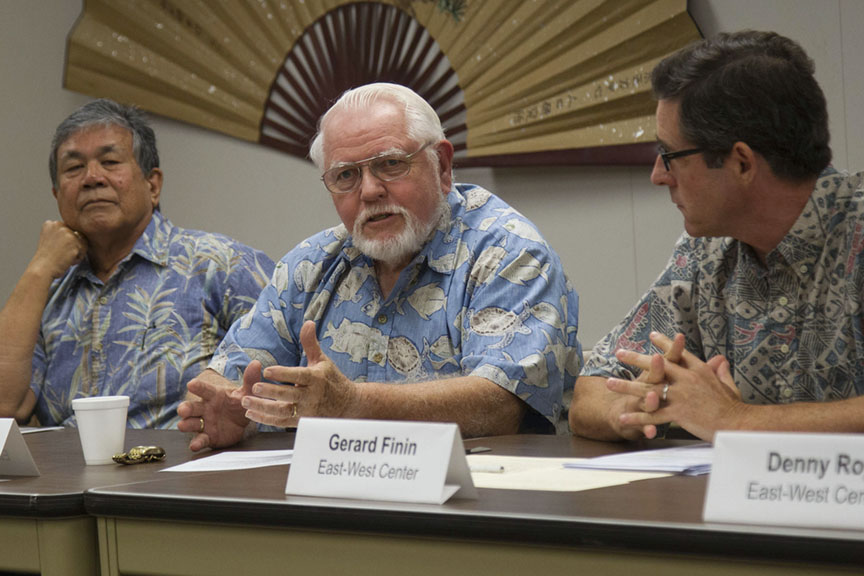 Allen Clark, senior fellow at the East-West Center Research Program, discusses the effects of unplanned urbanization and climate change. Photo courtesy of Harley Palangchao
Allen Clark, senior fellow at the East-West Center Research Program, discusses the effects of unplanned urbanization and climate change. Photo courtesy of Harley Palangchao
HONOLULU, Hawaii (MindaNews / 12 Feb) – The lack of urban development policy in the Philippines may even cause a more troubling impact on the economy and the poor urban migrants in several communities when natural calamities like typhoons hit, an expert from the East West Center here said Tuesday (Feb. 7).
Speaking to Filipino journalists participating in the US-Philippines Relations Reporting Tour, Allen Clark, senior fellow at the East West Center Research Program, said that the massive unplanned urbanization in the country’s urban centers when coupled with climate change and explosive population growth would cause “unparalleled disaster.”
“If you combine climate change and urbanization process and this increasingly marginalization of large group of people, future disasters are going to be much larger and much more severe than we’ve seen before,” he said.
He cited the impact of Super Typhoon Yolanda that wreaked havoc on November 8, 2013 in the Visayas area on November 8, 2013 where 6,300 lives perished and affected 1,473,251 families.
He said that the migration of families from rural area to the cities in search of a better life causes the rapid population growth in urban centers that is not “reported or dealt with as much as it should be.”
“It’s a matter of opportunities. There’s more money there,” he said.
Based on the September 1, 2016 report of the Philippine Statistics Authority (PSA), the total population in the Philippines as of August 1, 2015 reached 100.98 million and annual population growth rate of 1.72 percent from 2010 to 2015.
Only four out of 33 highly urbanized cities in the country surpassed the one million population mark, namely: Quezon City (2.94 million), City of Manila (1.78 million), Davao City (1.63 million), and Caloocan City (1.58 million), according to the PSA report.
But Clark said that the movement of people from rural to urban areas is alarming in a way that it creates more “slums and slum living,” which expose the families to even greater dangers when they choose to live in the metropolitan areas.
He said that more social problems are found in slums, which may become even worse if not addressed immediately.
“You’ve got all the social problems. That means a lot of your infrastructure developments – it has a very difficult time to put in place so you can’t actually improve the situation in terms of the overall urbanization process until you deal with these particular areas,” Clark said.
“In Asia, you have a massive explosion of urban slums. This is an issue which is not given anywhere near an emphasis as it should be because it’s creating this high number of people living in vulnerable situations,” he said.
Revise laws
Clark said the government must update two of its important laws on environment and disaster management to come up with a better and more congruent government effort in managing the impact of natural calamities in the country.
These laws, he said, are the Republic Act (RA) 9721, or the Climate Change Act, and the RA 10121, or the Philippine Disaster Risk Reduction and Management Act. Both laws were passed on July 27, 2009.
“But what we’re faced with in the present time is that those laws and those activities – because of other changes that we have been talking about – they desperately need to be updated in order to reassess where the emphasis should be, where the money should be placed, and what the priorities should be with respect to disaster management in the Philippines,” Clark said.
He lamented how much attention was given on the number of lives that perished during calamities while very little on the economic losses, which would often leave a long-term impact on families as they stand to lose their livelihoods.
“Those figures, in terms of fatalities, reflect a reality but in terms of money and impact, they underestimate the impact of disasters,” he said.
Clark emphasized the need to integrate the climate change adaptation program more into an actual development process to effectively manage the effects of natural calamities.
“The climate change adaptation is a huge area where you can have both local and large scale developments taking place simultaneously. The other one is basically the climate change development activities that are climate change-sensitive. It’s not really built into national development,” he said.
Clark said that poor families migrating into the cities tend to live in high risk areas.
“But the place more of these people can find to live is the lowest cost of land that is available either just to squat on or they purchase,” he said. (Antonio L. Colina IV / MindaNews)